Apartments and Flats of Downtown Indianapolis Thematic Resources
The Apartments and Flats of Downtown Indianapolis Thematic Resources is a multiple property submission of apartments on the National Register of Historic Places in downtown Indianapolis, Indiana. The area is roughly bounded by Interstate 65 and Fall Creek on the north, Interstate 65 and Interstate 70 on the east, Interstate 70 on the south, and Harding Street on the west.[1]:2
History
The 36 properties included in the nomination are generally in the period from 1890 to 1930, when Indianapolis was experiencing its greatest economic growth. The oldest property, the Sid-Mar, was built in 1887, while the youngest property, the Wyndham, was built in 1930.[1]:8
The need for apartments in downtown Indianapolis came about as a result of the city's industrial development during the late 19th century, led by the railroad and automobile industries, as well as Eli Lilly and Company. Banking, retail, and educational institutions grew during this time as well.[1]:14 The growth in population in Indianapolis after 1880 was fueled mostly by rural people moving to the city, as opposed to foreign immigration. The city was attractive to people who wanted educational, financial, and social advancement.[1]:14 The apartments and flats built in the city were an affordable alternative for people who wanted to move to the city before marrying or having children. Single women were needed in the workforce during World War I, so they found apartment dwelling acceptable. Young men moving from the countryside were moving away from living in boarding houses and choosing apartments.[1]:18–20
Architecture
A 1904 ordinance by the Indianapolis City Council outlawed wood-frame construction within the downtown area. All of these apartment buildings were built of brick, with some use of Indiana limestone used for ornamentation, lintels, and sills. Most of the buildings are three stories high, except for a few that were considered "high-rises". There is not a lot of differentiation between architectural styles. Most of the buildings use Classical Revival design features with symmetric facades, pilasters, keystones, and dentil and modillion cornices. Other architectural styles popular at the time, such as Gothic Revival and Second Empire are absent. The Blacherne has a few elements of Richardsonian Romanesque design, while a few bay windows show influence of Queen Anne style architecture in the United States. Tudor Revival architecture began its influence in the 1920s, with the Dartmouth and the Wyndham as examples. The McKay, built in 1924, has Art Deco detailing.[1]:8–9
Initially, an apartment was defined as a suite of two or three rooms without a kitchen. These were popular with young men. A flat was defined as five to seven rooms, including a kitchen and a dining room, and were attractive to young married couples as well as retired couples. The distinction began to fade by the 1920s, and "apartment" became the label for any multi-unit rental properties.[1]:20
Properties included in the nomination
There were 37 properties in the nomination. An additional eligible property, the Delmar, was demolished while the nomination was in progress.[1]:9[2] One of the 37 listed buildings, the St. Clair, was removed from the National Register in 1991.[1] The Chardwick and the Harriett were removed in 2011 due to destruction.
| Landmark name | Image | Date listed | Location | City or Town | Summary | |
|---|---|---|---|---|---|---|
| 1 | The Alameda | 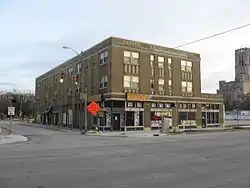 |
September 15, 1983 | 37 W. St. Clair St. 39°46′41″N 86°9′33″W |
Indianapolis | |
| 2 | The Alexandra | 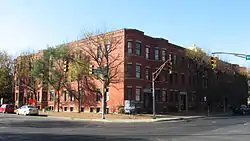 |
September 15, 1983 | 402-416 N. New Jersey St. and 332-336 E. Vermont St. 39°46′22″N 86°9′2″W |
Indianapolis | An enlarged "Eastern" flat.[1] |
| 3 | The Ambassador |  |
September 15, 1983 | 39 E. 9th St. 39°46′44″N 86°9′21″W |
Indianapolis | |
| 4 | The Baker |  |
September 15, 1983 | 310 N. Alabama St. and 341 Massachusetts Ave. 39°46′18″N 86°9′9″W |
Indianapolis | |
| 5 | The Blacherne | 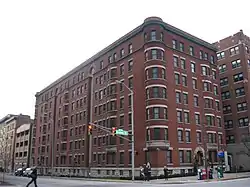 |
September 15, 1983 | 402 N. Meridian St. 39°46′22″N 86°9′29″W |
Indianapolis | Built in 1895 and owned by Lew Wallace, the Blacherne was a fashionable residential address for leaders in Indianapolis business and society. Wallace lived in the building during the city's winter social season. The success of this apartment building spurred the construction of many others during the ensuing decade.[1] |
| 6 | The Burton | 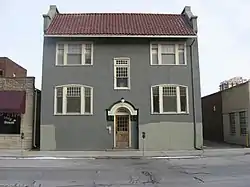 |
September 15, 1983 | 821-823 N. Pennsylvania St. 39°46′42″N 86°9′20″W |
Indianapolis | |
| 7 | The Cathcart | 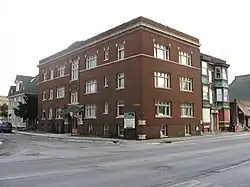 |
September 15, 1983 | 103 E. 9th St. 39°46′44″N 86°9′20″W |
Indianapolis | |
| 8 | The Chadwick | 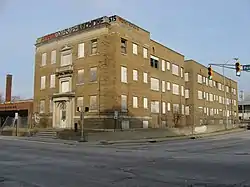 |
September 15, 1983 | 1005 N. Pennsylvania St. 39°46′52″N 86°9′19″W |
Indianapolis | The Chadwick was destroyed by fire in January 2011 and delisted later that year. |
| 9 | The Colonial |  |
September 15, 1983 | 126 E. Vermont St. and 402-408 N. Delaware St. 39°46′22″N 86°9′15″W |
Indianapolis | |
| 10 | The Dartmouth | 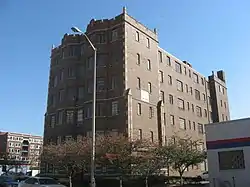 |
September 15, 1983 | 221 E. Michigan St. 39°46′29″N 86°9′12″W |
Indianapolis | |
| 11 | Delaware Court | 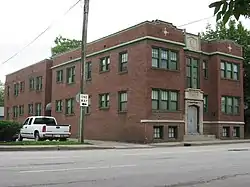 |
September 15, 1983 | 1001-1015 N. Delaware St. 39°46′52″N 86°9′13″W |
Indianapolis | Built in 1916-17 by developer George William Brown.[1] |
| 12 | Delaware Flats | 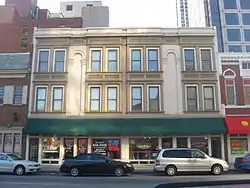 |
September 15, 1983 | 120-128 N. Delaware St. 39°46′8″N 86°9′16″W |
Indianapolis | Built in 1887.[1] |
| 13 | The Devonshire | 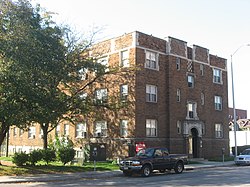 |
September 15, 1983 | 412 N. Alabama St. 39°46′24″N 86°9′9″W |
Indianapolis | |
| 14 | The Emelie |  |
September 15, 1983 | 326-330 N. Senate Ave.and 301-303 W. Vermont St. 39°46′21″N 86°9′48″W |
Indianapolis | |
| 15 | The Glencoe | 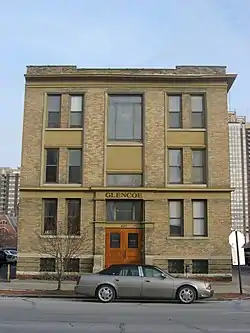 |
September 15, 1983 | 627 N. Pennsylvania St. 39°46′35″N 86°9′20″W |
Indianapolis | |
| 16 | The Grover | 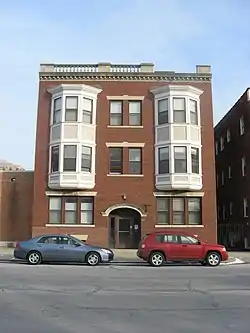 |
September 15, 1983 | 615 N. Pennsylvania St. 39°46′34″N 86°9′20″W |
Indianapolis | |
| 17 | The Harriett | September 15, 1983 | 124-128 N. East St. 39°46′9″N 86°8′57″W |
Indianapolis | The Harriett was demolished and subsequently delisted in 2011 | |
| 18 | The Lodge | 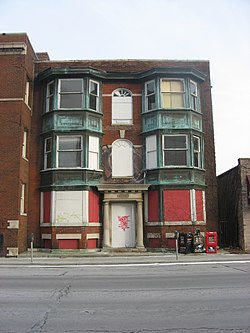 |
September 15, 1983 | 829 N. Pennsylvania St. 39°46′43″N 86°9′20″W |
Indianapolis | Built in 1905 by developer E.G. Spink for Caleb N. Lodge, this is an example of the "Eastern" flat type.[1] |
| 19 | The Martens | 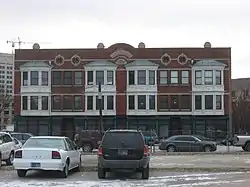 |
September 15, 1983 | 348-356 Indiana Ave. 39°46′20″N 86°9′47″W |
Indianapolis | |
| 20 | The Massachusetts | 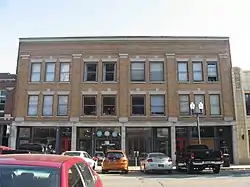 |
September 15, 1983 | 421-427 Massachusetts Ave. 39°46′24″N 86°9′3″W |
Indianapolis | |
| 21 | The Mayleeno | 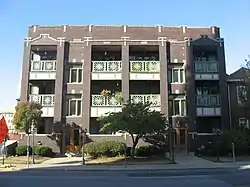 |
September 15, 1983 | 416-418 E. Vermont St. 39°46′22″N 86°8′59″W |
Indianapolis | |
| 22 | The McKay | 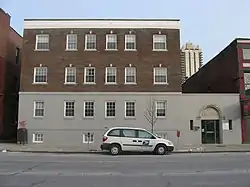 |
September 15, 1983 | 611 N. Pennsylvania St. 39°46′33″N 86°9′20″W |
Indianapolis | |
| 23 | The Myrtle Fern | 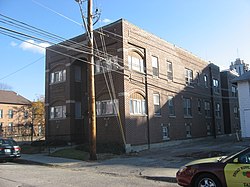 |
September 15, 1983 | 221 E. 9th St. 39°46′44″N 86°9′11″W |
Indianapolis | |
| 24 | The Oxford | 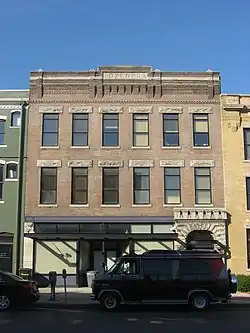 |
September 15, 1983 | 316 E. Vermont St. 39°46′22″N 86°9′6″W |
Indianapolis | |
| 25 | The Pennsylvania |  |
September 15, 1983 | 919 N. Pennsylvania St. 39°46′46″N 86°9′19″W |
Indianapolis | Built in 1906 by developer George William Brown, the Pennsylvania is an example of the "Eastern" flat type.[1] |
| 26 | The Plaza |  |
September 15, 1983 | 902 N. Pennsylvania St. and 36 E. 9th St. 39°46′45″N 86°9′21″W |
Indianapolis | |
| 27 | The Rink |  |
September 15, 1983 | 401 N. Illinois St. 39°46′22″N 86°9′34″W |
Indianapolis | |
| 28 | The Savoy | 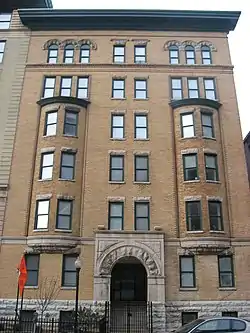 |
September 15, 1983 | 36 W. Vermont St. 39°46′22″N 86°9′32″W |
Indianapolis | |
| 29 | The Shelton | 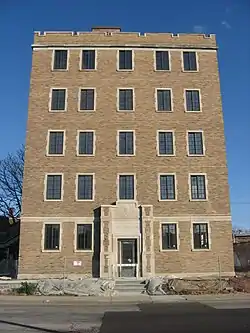 |
September 15, 1983 | 825 N. Delaware St. 39°46′42″N 86°9′13″W |
Indianapolis | |
| 30 | The Sid-Mar | 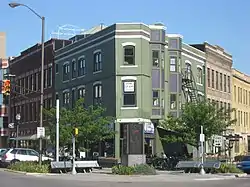 |
September 15, 1983 | 401-403 Massachusetts Ave. 39°46′22″N 86°9′7″W |
Indianapolis | Built in 1887.[1] |
| 31 | The Spink | 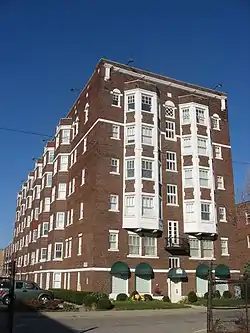 |
September 15, 1983 | 230 E. 9th St. 39°46′45″N 86°9′10″W |
Indianapolis | |
| 32 | The Sylvania | 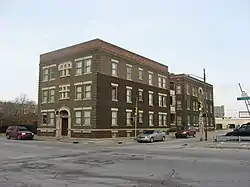 |
September 15, 1983 | 801 N. Pennsylvania St. and 108 E. St. Clair St. 39°46′41″N 86°9′20″W |
Indianapolis | |
| 33 | The Vienna |  |
September 15, 1983 | 306 E. New York St. 39°46′17″N 86°9′8″W |
Indianapolis | Built in 1908 by developer George William Brown.[1] |
| 34 | The Wil-Fra-Mar | 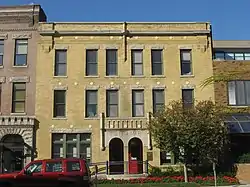 |
September 15, 1983 | 318-320 E. Vermont St. 39°46′22″N 86°9′5″W |
Indianapolis | Built after 1887, the Wil-Fra-Mar is an early example of the "Eastern" flat type.[1] |
| 35 | Wilson | 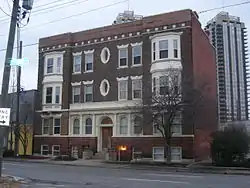 |
September 15, 1983 | 643 Ft. Wayne Ave. 39°46′34″N 86°9′17″W |
Indianapolis | |
| 36 | The Wyndham | 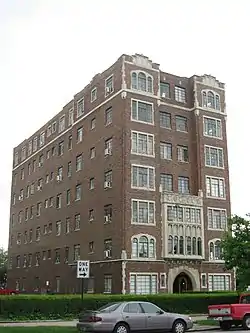 |
September 15, 1983 | 1040 N. Delaware St. 39°46′56″N 86°9′14″W |
Indianapolis |
References
- Niggle, Karen S. & Sheryl D. Robinson (1983-02-28). "Apartments and Flats of Downtown Indianapolis TR". National Park Service. Retrieved 2010-02-02.
- "National Register Information System". National Register of Historic Places. National Park Service. March 13, 2009.